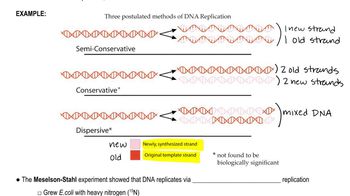Table of contents
- 1. Introduction to Genetics51m
- 2. Mendel's Laws of Inheritance3h 37m
- 3. Extensions to Mendelian Inheritance2h 41m
- 4. Genetic Mapping and Linkage2h 28m
- 5. Genetics of Bacteria and Viruses1h 21m
- 6. Chromosomal Variation1h 48m
- 7. DNA and Chromosome Structure56m
- 8. DNA Replication1h 10m
- 9. Mitosis and Meiosis1h 34m
- 10. Transcription1h 0m
- 11. Translation58m
- 12. Gene Regulation in Prokaryotes1h 19m
- 13. Gene Regulation in Eukaryotes44m
- 14. Genetic Control of Development44m
- 15. Genomes and Genomics1h 50m
- 16. Transposable Elements47m
- 17. Mutation, Repair, and Recombination1h 6m
- 18. Molecular Genetic Tools19m
- 19. Cancer Genetics29m
- 20. Quantitative Genetics1h 26m
- 21. Population Genetics50m
- 22. Evolutionary Genetics29m
8. DNA Replication
Overview of DNA Replication
Problem 21a
Textbook Question
Raymond Rodriguez and colleagues demonstrated conclusively that DNA replication in E. coli is bidirectional. Explain why locating the origin of replication on one side of the circular chromosomes and the terminus of replication on the opposite side of the chromosome supported this conclusion.
 Verified step by step guidance
Verified step by step guidance1
<span>Understand the structure of E. coli's chromosome: E. coli has a circular chromosome, which means that replication can potentially proceed in two directions from a single starting point.</span>
<span>Identify the origin of replication: The origin of replication (oriC) is the specific location on the chromosome where DNA replication begins.</span>
<span>Recognize the terminus of replication: The terminus is the point on the chromosome where replication ends, located approximately opposite the origin on the circular chromosome.</span>
<span>Consider the implications of bidirectional replication: If replication is bidirectional, it means that two replication forks move away from the origin in opposite directions, meeting at the terminus.</span>
<span>Analyze the evidence: The fact that the origin and terminus are on opposite sides of the chromosome supports the idea that replication proceeds in two directions, as the replication forks would meet at the terminus if they started from the origin and moved in opposite directions.</span>
Recommended similar problem, with video answer:
 Verified Solution
Verified SolutionThis video solution was recommended by our tutors as helpful for the problem above
Video duration:
1mPlay a video:
Was this helpful?
Key Concepts
Here are the essential concepts you must grasp in order to answer the question correctly.
Bidirectional DNA Replication
Bidirectional DNA replication refers to the process where DNA strands are synthesized in two opposite directions from a single origin of replication. In prokaryotes like E. coli, this means that replication begins at a specific point and proceeds outward in both directions until the entire circular chromosome is copied. This mechanism is crucial for efficient and rapid DNA replication.
Recommended video:
Guided course

Steps to DNA Replication
Origin and Terminus of Replication
The origin of replication is the specific location on the DNA where replication begins, while the terminus is the point where replication ends. In E. coli, the origin is located on one side of the circular chromosome, and the terminus is on the opposite side. This spatial arrangement supports the bidirectional nature of replication, as it allows two replication forks to move away from the origin simultaneously.
Recommended video:
Guided course

Semiconservative Replication
Circular Chromosome Structure
E. coli and many other prokaryotes possess circular chromosomes, which differ from the linear chromosomes found in eukaryotes. This circular structure allows for a continuous replication process, as the replication forks can meet at the terminus after traveling around the entire chromosome. The circular nature of the DNA is essential for understanding how replication can occur bidirectionally and efficiently.
Recommended video:
Guided course

Chromosome Structure

 5:02m
5:02mWatch next
Master Directionality with a bite sized video explanation from Kylia Goodner
Start learning


